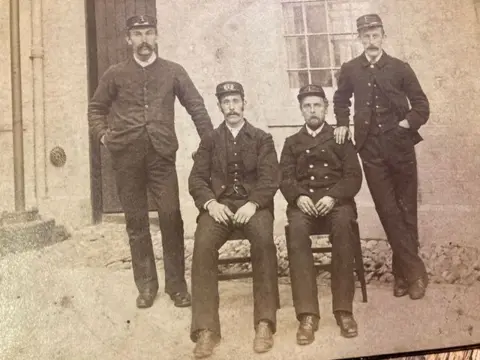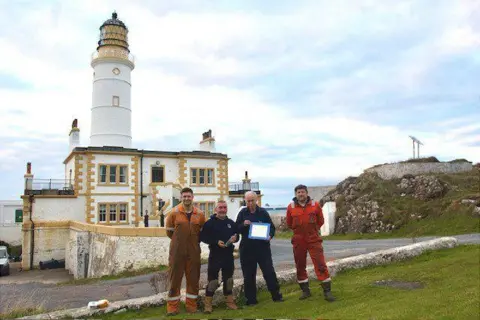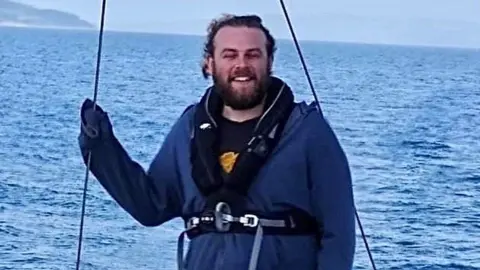 Ross Russell
Ross RussellEngineers found a bottle with a 132-year-old message inside the walls of a lighthouse in southern Scotland.
The bottle was found at the Corsewall Lighthouse at the northernmost point of the Rhins of Galloway.
The “once in a lifetime” find is understood to be the first message in a bottle found at a lighthouse in Scotland.
Written in quill and ink, the letter dated September 4, 1892 names three engineers who installed a new type of light on a 30ft tower.
It also has the names of three lighthouse keepers.
The 8in (20cm) bottle was found by Ross Russell, the Northern Lighthouse Board’s mechanical engineer, during an inspection.
He was spotted after removing a panel in the closet but was out of reach. The team took it using a device made from a rope and a broom handle.
But he waited until the detained lighthouse keeper, Barry Miller, arrived before opening it.
“Oh my gosh I’m thankful for them,” he said.
The bottle has an unusual convex bottom, meaning it cannot stand upright, and is made of rough glass, full of tiny air bubbles.
It is thought to have been filled with oil.
The bottle stopper is a cork, which has expanded over time and stuck to the glass, while the wire that holds it in place has rusted away.
 Ross Russell
Ross RussellThey had to cut the cork at the top and carefully drill through the cork.
The note initially seemed too big to pull through the neck of the bottle, so he made a tool using two pieces of wire to wind it through the narrow opening.
Mr Miller, 77, told BBC Scotland News his hand was shaking as he opened it.
“It’s really fun, it’s like meeting friends from the past. It’s like being there,” he said.
“It’s like touching them. It’s like they’re part of our team instead of just the four of us there, we’re all there sharing what they wrote because it’s real and you can see their handwriting style.
“You know what he’s done. You know he’s hiding it somewhere he won’t be found for a long time.”
What does the letter say?
 Ross Russell
Ross RussellCorsewall Light & Fog Signal Station, 4 September 1892.
The lantern was erected by James Wells Engineer, John Westwood Millwright, James Brodie Engineer, David Scott Labourer, of the firm of James Milne & Son Engineers, Milton House Works, Edinburgh, during the months of May to September and commenced on Thursday night the 15th. September 1892.
The following were the station keepers at this time, John Wilson Principal, John B Henderson 1st assistant, John Lockhart 2nd assistant.
Lenses and engines were supplied by James Dove & Co Engineers Greenside Edinburgh and erected by William Burness, John Harrower, James Dods. Engineers with top companies.
‘I was very surprised’
 Jane Murray
Jane MurrayRoss Russell, from Oban, who found the bottle with colleagues Morgan Dennison and Neil Armstrong, said it was an unbelievable find.
“The record is just sensational, I’m in total shock,” Ross said.
“Being the first person to touch the bottle after 132 years is exciting.
“It’s a once in a lifetime find.”
 Ross Russell
Ross RussellEngineers had traveled to the 209-year-old lighthouse earlier in the year’s project to inspect the rotating five-ton lens bearings.
He was trying to check under the floor to see if the part could hold the lens when there was no cushion when he found the bottle.
The people who wrote the note in 1892 had been at the lighthouse to install lanterns and different glazing on top of the tower.
“It was just a strange coincidence to find the notes while working on the equipment described in the notes,” Ross said.
36-year-old said they planned to change notes and bottles where they found and also add more of their own.
The bottle and records are now kept at the Northern Lighthouse Board headquarters in Edinburgh.
 Euan Murray
Euan MurrayMeanwhile, the descendants of one of the lighthouse keepers said they were thrilled with the discovery.
Euan Murray, who grew up 10 miles (16km) from the lighthouse in Stranraer, is the great grandson of Robert Murray who worked with John Wilson in Corsewall.
“I think it’s really interesting to see a family history that looks like this,” he said.
The 32-year-old added: “It’s amazing that the work he did then is still relevant today, even in the age of satellite navigation.”
The Royal Navy’s chief engineer said: “Ships still use this lighthouse to navigate safely every day.
“Everything is more visible because of a career at sea and has passed the lighthouse many times in ships coming and going from around the world. Always a good sign from the front.”





